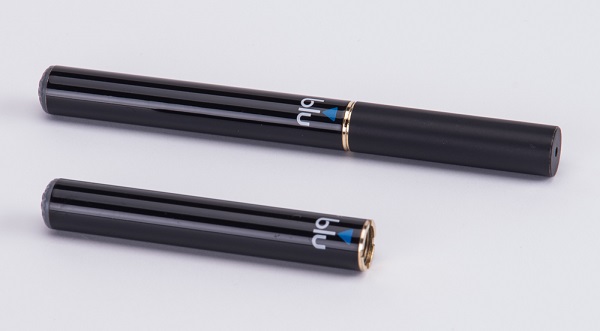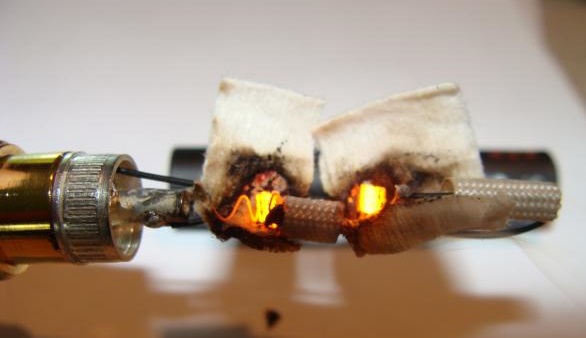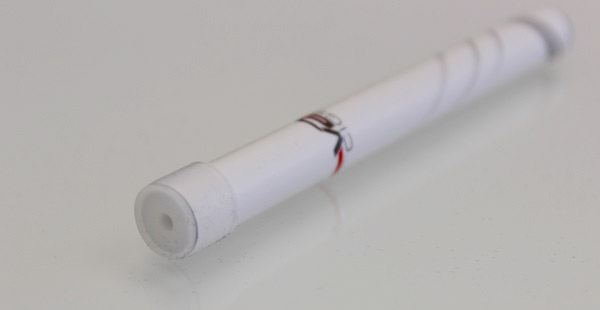
The first experience many vapers have with e-cigarettes is through a KR-808, pen-sized model, so learning to use them safely is essential. If you’re new to vaping and you’ve picked up an e-cig from a brand like V2 Cigs or Blu, thankfully it’s pretty easy to use it safely. With screw-in-and-puff operation, disposable cartomizers and no requirement for technical expertise, all you have to do is learn some basic tips and you'll be able to vape without worry!
Key Points
- E-cig cartomizers can and do get hot. If you notice the outside getting hot, let it rest for a while – either have a short break from vaping or switch to a different cartomizer.
- Change cartomizers when you notice a burnt taste or a reduction in vapor production or flavor.
- Store your e-cig batteries at temperatures of around 59 °F (15 °C), avoiding either extreme highs or lows, and if you won’t use it for an extended period of time, keep it around half-depleted.
- Don’t modify components with beginner e-cigs; wait until you know more and have a device more suitable to modification.
E-Cig Cartomizers Can Get Hot
If you get right down to the basics, an e-cigarette is an electronic heating device. The electricity runs through the heating coil when you activate it, vaporizing the liquid inside the cartridge through the increase in temperature. Keeping that in mind, it should be clear that heat is unavoidable when you’re vaping. Although the coil itself is tucked away towards the center of the cartomizer, the outside of it (effectively a metallic cylinder) can start to get warm if you’re vaping for a while.
A little heat is to be expected, but if you notice your cartomizer starting to get significantly hot, it’s best to put it aside for a few minutes and allow it to cool down.
Alternatively, you can just switch cartomizers for a short while and continue to vape. If you take a cigarette’s worth of puffs (15 or so) you’re unlikely to experience much heat at all, but if you’re “chain” vaping it can present an issue. Ordinarily, coils reach about 120 °F (around 50 °C), and the longer you use it continuously, the more time that heat has to transfer to the outside of the cartomizer and risk burning you. Given that you’ll hold your e-cig like a regular cigarette, your fingers will be in contact with (or at least close to) the cartomizer, so you should be able to identify the problem quickly and let it rest before continuing.
If you’re ever in a situation where your cartomizer has gotten very hot, treat it like you would any other hot metal – don’t touch it bare-handed and leave it somewhere safe to cool!
When to Change a Cartomizer
The liquid you vape is contained in absorbent “wick” material, but the juice won’t last forever. Determining that your cartomizer is empty gets easier with experience, but the most obvious sign is a “burnt” taste caused by the dry-heating of the wicking material. This won’t escape your notice; it isn’t pleasant. When this happens, you’re effectively “smoking” the wick material, so you definitely shouldn’t do so at length.

You can also determine that your cartomizer is in need of a change by a reduction in vapor production and a lack of flavor, but a depleted battery also reduces vapor production.
You can test to see why you aren’t getting as much vapor by screwing your cartomizer onto a spare battery and seeing if the problem persists – if the situation improves, you probably just need to charge the original battery.
How to Store Your E-Cig
Keep your battery away from extreme highs and lows of temperature, and don’t keep it in a moist environment like your kitchen or bathroom.
Generally speaking, lithium ion batteries should be stored at around 59 °F (15 °C), according to Battery University.
Aside from a risk of damaging components, exposure to harsh environments will reduce the capacity (the lifespan on a full charge) of your battery, which translates to more charging and less vaping!
It’s also better to store them at around half-charge (which is how they come when you buy them new) if it’s for a long period of time.
Additionally, cover the tip of your cartomizer with one of the plastic end-pieces (also known as rubber caps or condoms) they come with to minimize evaporation of the juice inside during storage.

Beginner E-Cigs Are Not the Place to Modify Components
As you become accustomed to vaping and learn more about the different options available, you may be interested in “modifying” your e-cig. If you’re using a beginner-friendly, pen-sized model, this is not advised. If you do something wrong, you could end up with anything from a useless, broken device to a catastrophic battery failure.
Don’t attempt any technical modifications unless you know what you’re doing, and even then, advanced e-cigs are much more amenable to modding than beginner models. Why take the risk trying to cram more power or additional coils into such a limited space?
Conclusion
If you take a few simple safety precautions, you can use your new e-cig safely and focus your attention on kicking the deadly alternative!
Check out the next article in the series for the essential info on charging your e-cig!
The Complete Guide to E-Cig Safety
Part One: Beginner E-Cigs Safety
1. Safe Use of Beginner E-Cigs
2. A Guide to Safe Charging
3. Carrying Your E-Cig Safely
4. Cartomizer Safety
5. Vaping and Driving
Part Two: E-Liquid Safety
6. Basic E-Liquid Safety
7. Allergies, Conditions and E-Liquid
8. Safe Nicotine Consumption for Vapers
9. Steeping E-Liquids Safely
10. Do E-Liquids Expire?
11. E-Liquid and Tank Safety
12. DIY E-Liquid Safety
Part Three: E-Cig Mod Safety
13. Minimizing the Risk of E-Cig Mod Explosions
14. E-Cig Mod Battery Safety and Ohm’s Law
15. Rebuildable Atomizer Safety
16. Mechanical Mod Safety
17. Wick Safety
18. Drip Tip Safety

